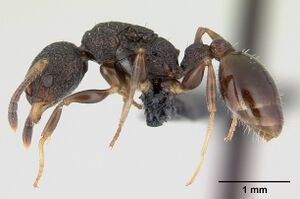Nesomyrmex sikorai
| Nesomyrmex sikorai | |
|---|---|

| |
| Scientific classification | |
| Kingdom: | Animalia |
| Phylum: | Arthropoda |
| Class: | Insecta |
| Order: | Hymenoptera |
| Family: | Formicidae |
| Subfamily: | Myrmicinae |
| Tribe: | Crematogastrini |
| Genus: | Nesomyrmex |
| Species group: | sikorai |
| Species: | N. sikorai |
| Binomial name | |
| Nesomyrmex sikorai (Emery, 1896) | |
This species is known to occur in montane rainforests between elevations of 200 m and 520 m in central Madagascar.
Identification
A member of the sikorai species-group.
Keys including this Species
Distribution
Latitudinal Distribution Pattern
Latitudinal Range: -18.92207° to -23.4635°.
| North Temperate |
North Subtropical |
Tropical | South Subtropical |
South Temperate |
- Source: AntMaps
Distribution based on Regional Taxon Lists
Malagasy Region: Madagascar (type locality).
Distribution based on AntMaps
Distribution based on AntWeb specimens
Check data from AntWeb
Countries Occupied
| Number of countries occupied by this species based on AntWiki Regional Taxon Lists. In general, fewer countries occupied indicates a narrower range, while more countries indicates a more widespread species. |

|
Estimated Abundance
| Relative abundance based on number of AntMaps records per species (this species within the purple bar). Fewer records (to the left) indicates a less abundant/encountered species while more records (to the right) indicates more abundant/encountered species. |

|
Biology
Castes
Worker
Images from AntWeb
   
| |
| Queen (alate/dealate). Specimen code casent0141299. Photographer Erin Prado, uploaded by California Academy of Sciences. | Owned by CAS, San Francisco, CA, USA. |
   
| |
| Worker. Specimen code casent0189277. Photographer Erin Prado, uploaded by California Academy of Sciences. | Owned by CAS, San Francisco, CA, USA. |
    
| |
| Worker. Specimen code casent0102064. Photographer April Nobile, uploaded by California Academy of Sciences. | Owned by MSNG, Genoa, Italy. |
Nomenclature
The following information is derived from Barry Bolton's Online Catalogue of the Ants of the World.
- sikorai. Leptothorax (Goniothorax) sikorai Emery, 1896g: 63 (w.) MADAGASCAR.
- Combination in Nesomyrmex: Bolton, 2003: 272.
- Status as species: Bolton, 1995b: 244; Csösz & Fisher, 2016b: 25 (redescription).
Type Material
- Holotype, worker, Imerina (Antananarivo), Madagascar, 18°55′S 47°33′E / 18.91°S 47.55°E, Sikora, CASENT0102064, Musee d'Histoire Naturelle Genève.
Csösz and Fisher (2016) - The type was not available for morphometric investigation; high-quality AntWeb images were used for comparison.
Unless otherwise noted the text for the remainder of this section is reported from the publication that includes the original description.
Description
Worker
Csösz and Fisher (2016) - Body color: black. Body color pattern: concolorous. Absolute cephalic size: 822 μm [748, 890]. Cephalic length vs. maximum width of head capsule (CL/CWb): 1.169 [1.126, 1.226]. Postocular distance vs. cephalic length (PoOc/CL): 0.488 [0.451, 0.511]. Postocular sides of cranium contour, anterior view orientation: converging posteriorly. Postocular sides of cranium contour, anterior view shape: strongly convex. Vertex contour line in anterior view shape: straight to feebly convex. Vertex sculpture: main sculpture areolate, ground sculpture areolate. Gena contour line in anterior view shape: convex. Gena contour from anterior view orientation: strongly converging. Gena sculpture: rugoso-reticulate with areolate ground sculpture. Concentric carinae laterally surrounding antennal foramen: present. Eye length vs. absolute cephalic size (EL/CS): 0.212 [0.201, 0.224]. Frontal carina distance vs. absolute cephalic size (FRS/CS): 0.292 [0.276, 0.312]. Longitudinal carinae on median region of frons: present. Smooth median region on frons: absent. Antennomere count: 12. Scape length vs. absolute cephalic size (SL/CS): 0.828 [0.78, 0.862]. Median clypeal notch: present. Median carina of clypeus: present or absent. Spine length vs. absolute cephalic size (SPST/CS): 0.269 [0.221, 0.301]. Minimum spine distance vs. absolute cephalic size (SPBA/CS): 0.253 [0.215, 0.287]. Apical spine distance vs. absolute cephalic size (SPTI/CS): 0.299 [0.256, 0.341]. Propodeal spine shape: straight; triangular, blunt. Apical distance of pronotal spines vs. absolute cephalic size (PSTI/CS): 0.665 [0.636, 0.691]. Metanotal depression: present. Dorsal region of mesosoma sculpture: areolate main sculpture, interstices areolate. Lateral region of pronotum sculpture: areolate ground sculpture, main sculpture areolate. Mesopleuron sculpture: areolate ground sculpture, superimposed by dispersed rugae. Metapleuron sculpture: areolate ground sculpture, superimposed by coarse rugae. Petiole width vs. absolute cephalic size (PEW/CS): 0.269 [0.228, 0.326]. Dorsal region of petiole sculpture: ground sculpture areolate, main sculpture rugoso-reticulate. Postpetiole width vs. absolute cephalic size (PPW/CS): 0.37 [0.348, 0.391]. Dorsal region of postpetiole sculpture: ground sculpture smooth, main sculpture absent.
References
- Bolton, B. 2003. Synopsis and Classification of Formicidae. Mem. Am. Entomol. Inst. 71: 370pp (page 272, Combination in Nesomyrmex)
- Csösz, S. & Fisher, B.L. 2016b. Toward objective, morphology-based taxonomy: a case study on the Malagasy Nesomyrmex sikorae species group. PLoS ONE 11 (4): 31 pp. e0152454. doi: 10.1371/journal.pone.0152454.
- Emery, C. 1896g. Studi sulle formiche della fauna neotropica. XVII-XXV. Bull. Soc. Entomol. Ital. 28: 33-107 (page 63, worker described)
References based on Global Ant Biodiversity Informatics
- Fisher B. L. 2003. Formicidae, ants. Pp. 811-819 in: Goodman, S. M.; Benstead, J. P. (eds.) 2003. The natural history of Madagascar. Chicago: University of Chicago Press, xxi + 1709 pp.

